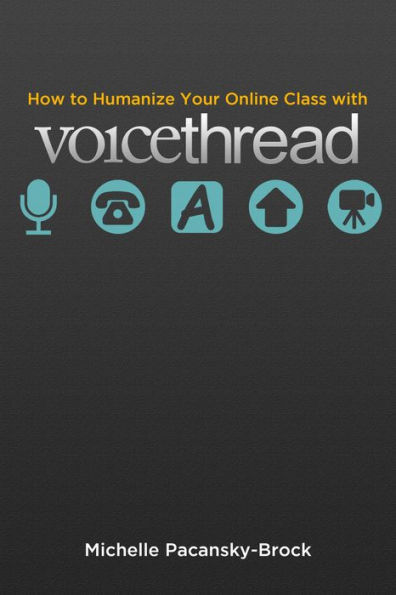VoiceThread is a web 2.0 tool that turns media files into asynchronous conversations using voice, video, or text comments. This book is a pedagogical support resource for educators seeking to understand how to use VoiceThread to deliver content infused with human presence, build online community through asynchronous communications, and improve student learning outcomes.
The author, Michelle Pacansky-Brock, is a noted online educator and has received two Sloan-C awards, one specifically for her use of VoiceThread. The book compiles years of Pacansky-Brock's teaching research and practices into one place and is illustrated with video excerpts from her own VoiceThread activities and links to samples.
The book is a resource for online instructors, faculty development specialists, instructional designers, and graduate students.
Chapter One: Maximizing Human Presence
This chapter examines the topic of social presence and the significant value it brings to both community building and improving learning in online classes. The chapter looks at recent research that explores the benefits of asynchronous voice and video in improving social presence. The chapter also examines the use of VoiceThread as an effective tool for applying principles of Universal Design for Learning (UDL) in online classes and demystifies some of the confusing misconceptions about accessibility and 508 compliance by pointing out what needs to be captioned or transcribed in a VoiceThread (and explains how to do it). The chapter ends with an overview of a proven strategy for increasing students' voluntary voice or video comments.
Chapter Two: Rethinking Learning
This chapter recontextualizes learning from our formalized academic framework into everyday language. The chapter looks at concepts like scaffolding and flow and applies them to Bloom's taxonomy. Specific examples of how the author has used VoiceThread as a formative assessment tool to scaffold learning in a flipped classroom are discussed, along with student survey results. Chapter 2 also examines the importance of encouraging 21st century students to become content creators, and examines how VoiceThread is effective for fostering this skill. To lead students towards this skill, the author suggests scaffolding students' VoiceThread skills by developing them from beginners using the commenting feature to editors of VoiceThreads and then creators of their own VoiceThreads. To demonstrate this process, Pacansky-Brock carefully explains the steps of a student-edited VoiceThread project and a student-created VoiceThread project from her own class with links to examples includes and her own instructor reflections.
Chapter 3: Eight Elements of an Effectively Designed VoiceThread
Discusses the nuts n' bolts of how to put together a solid VoiceThread activity that communicates clear expectations, grading criteria, fosters consistent norms, directs students appropriately to where they should comment (when, how many times). Further tips, illustrations of sample slides, and a video tutorial of a sample VoiceThread are included.
Chapter 4: Facilitating Learning with Feedback
One of the most valuable and important components of a learner's growth and development comes from the feedback she receives from a teacher. When a student is learning online and the feedback is delivered in a timely manner through warm voice or video, the results are greatly improved from text-based feedback. This chapter guides the reader through some important mechanics about how to facilitate feedback effectively with VoiceThread using a system the author has developed using VoiceThread's Identities and special "feedback" avatars plus the comment re-ordering feature. Different strategies for leaving feedback for students are discussed, including how to model norms through feedback, how to deliver micro-lectures through feedback, and more. All of these examples are illustrated with video excerpts.



